Polymer Flooding Injectivity Maintaining and Enhancement Strategies: A Field Case Study of Chinese Offshore EOR Project
Abstract
1. Introduction
2. Field Case Study
3. Injectivity Enhancement Strategy and Onsite Testing
3.1. Surface Optimization for Polymer Preparation
3.2. Downhole Wellbore Stimulation
3.3. Reservoir–Polymer Compatibility
3.3.1. Method and Material
3.3.2. Laboratory Testing Results
3.3.3. Field Validation
4. Discussion
5. Conclusions
- (1)
- A few strategies targeting from surface, wellbore, and reservoir are proposed and implemented to enhance the injectivity of the Q oilfield;
- (2)
- Proposed strategies are effective in improving the injectivity;
- (3)
- Polymer solution quality should be well controlled during the polymer fluid preparation process to avoid fish eyes entering the reservoir causing plugging;
- (4)
- Acidizing is an effective measure to clean the skin formed due to plugging, although the cost is high and may corrode the tubing;
- (5)
- The well completion parameters are critical for injectivity, longer perforation channels favor the polymer injection, and the plugged sand control screen is another key factor causing downhole plugging;
- (6)
- Proper polymer MW selection is the key to maintaining long-term desirable injectivity;
- (7)
- Proposed strategies provide insights into resolving the injectivity loss and could be useful for operators implementing offshore EOR projects.
Author Contributions
Funding
Data Availability Statement
Acknowledgments
Conflicts of Interest
Appendix A
| Wells | A | B | C | D | E |
|---|---|---|---|---|---|
| Injection Rate (m3/d) | 500 | 445 | 605 | 240 | 260 |
| Polymer Concentration (ppm) | 1200 | 1400 | 1400 | 1000 | 1200 |
| Well Completions | Pre-packed Screen | Wire-wrapped Screen/Gravel Pack | |||
| Screen Size (μm) | 150 | 150 + 20/40 | |||
References
- Li, Q.; Li, Q.; Cao, H.; Wu, J.; Wang, F.; Wang, Y. The Crack Propagation Behaviour of CO2 Fracturing Fluid in Unconventional Low Permeability Reservoirs: Factor Analysis and Mechanism Revelation. Processes 2025, 13, 159. [Google Scholar] [CrossRef]
- Li, Q.; Li, Q.; Wu, J.; Li, X.; Li, H.; Cheng, Y. Wellhead Stability During Development Process of Hydrate Reservoir in the Northern South China Sea: Evolution and Mechanism. Processes 2025, 13, 40. [Google Scholar] [CrossRef]
- Liu, H.; Li, J.; Yan, J.; Wang, W.; Zhang, Y.; Zhao, L. Successful Practices and Development of Polymer Flooding in Daqing Oilfield. In Proceedings of the Asia Pacific Oil and Gas Conference & Exhibition, Jakarta, Indonesia, 4–6 August 2009. [Google Scholar] [CrossRef]
- Jabri, R.; Mjeni, R.; Gharbi, M.; Alkindi, A. Optimizing Field Scale Polymer Development in Strong Aquifer Fields in the South of the Sultanate of Oman. In Proceedings of the SPE Middle East Oil and Gas Show and Conference, Manama, Bahrain, 18–21 March 2019. [Google Scholar] [CrossRef]
- Delamaide, E. Review of Canadian Field Cases of Chem ical Floods with Associative Polymer. In Proceedings of the SPE Improved Oil Recovery Conference, Virtual, 31 August–4 September 2020. [Google Scholar] [CrossRef]
- Shankar, V.; Sharma, G. Decoding the Impact of Injection-Induced Fractures on the Sweep Efficiency of a Mature Polymer Flood through Pressure Falloff Analysis. SPE Res. Eval. Eng. 2023, 26, 348–364. [Google Scholar] [CrossRef]
- Lu, X.; Li, W.; Wei, Y.; Xu, J. A Review on the Largest Polymer Flood Project in the World. In Proceedings of the SPE Annual Technical Conference and Exhibition, Houston, TX, USA, 3–5 October 2022. [Google Scholar] [CrossRef]
- Needham, R.B.; Doe, P.H. Polymer Flooding Review. J. Pet. Technol. 1987, 39, 1503–1507. [Google Scholar] [CrossRef]
- Wang, D.; Zhang, J.; Meng, F.; Liu, H.; Li, L.; Han, B.; Qi, L. Commercial Test of Polymer Flooding in Daqing Oil Field Daqing Petroleum Administrative Bureau. In Proceedings of the International Meeting on Petroleum Engineering, Beijing, China, 14–17 November 1995. [Google Scholar] [CrossRef]
- Song, W.; Zeng, X.; Yao, H.; Li, J.; Lv, X.; Tian, Y.; Guo, Y. Application of a New Crosslinked Polymer Displacement Technology at Bo-19 Block in Gudao Oilfield. In Proceedings of the SPE Asia Pacific Oil and Gas Conference and Exhibition, Melbourne, Australia, 8–10 October 2002. [Google Scholar] [CrossRef]
- Wang, Y.; He, L. Commercial Success of Polymer Flooding in Daqing Oilfield—Lessons Learned. In Proceedings of the SPE Asia Pacific Oil & Gas Conference and Exhibition, Adelaide, Australia, 11–13 September 2006. [Google Scholar] [CrossRef]
- Hongyan, W.; Xulong, C.; Jichao, Z.; Aimei, Z. Development and application of dilute surfactant–polymer flooding system for Shengli oilfield. J. Pet. Sci. Eng. 2009, 65, 45–50. [Google Scholar] [CrossRef]
- Caili, D.; Qing, Y.; Fulin, Z.; Hanqiao, J. Residual Polymer Reutilization for IOR after Polymer Flooding: From Laboratory to Field Application in Daqing Oilfield. Pet. Sci. Technol. 2011, 29, 2441–2449. [Google Scholar] [CrossRef]
- Gao, C.H. Experiences of Polymer Flooding Projects at Shengli Oilfield. In Proceedings of the SPE EOR Conference at Oil and Gas West Asia, Muscat, Oman, 31 March–2 April 2014. [Google Scholar] [CrossRef]
- Gao, S.; He, Y.; Zhu, Y.; Han, P.; Peng, S.; Liu, X. Associated Polymer ASP Flooding Scheme Optimization Design and Field Test after Polymer Flooding in Daqing Oilfield. In Proceedings of the SPE Improved Oil Recovery Conference, Virtual, 31 August–4 September 2020. [Google Scholar] [CrossRef]
- Zhu, Y.J.; Zhang, J.; Zhao, W.S.; Wang, S.S.; Jing, B.; Meng, F.X.; Zhang, H. Research on Efficient Polymer Dissolving Technology for Hydrophobically Associating Polymer Flooding on Offshore Platform. Appl. Mech. Mater. 2014, 670–671, 290–294. [Google Scholar] [CrossRef]
- Zhang, J.; Jing, B.; Fang, S.; Duan, M.; Ma, Y. Synthesis and performances for treating oily wastewater produced from polymer flooding of new demulsifiers based on polyoxyalkylated n,n-dimethylethanolamine. Polym. Adv. Technol. 2015, 26, 190–197. [Google Scholar] [CrossRef]
- Flavien, G.; Cao, X.; Ming, Y.; Yuan, F.; Gong, J.; Zhao, F.; Li, B.; Dorian, R.; Zhu, C.; Xie, K. Offshore Large Scale Polymer Flood Implementation at Chengdao Field. In Proceedings of the Offshore Technology Conference Asia, Virtual and Kuala Lumpur, Malaysia, 22–25 March 2022. [Google Scholar] [CrossRef]
- Wang, X.; Zhang, J.; Huang, B.; Duan, M. Degradable cationic clarifiers based on ester bonds for treating wastewater produced from polymer flooding. Can. J. Chem. Eng. 2023, 101, 2485–2492. [Google Scholar] [CrossRef]
- Zhang, J.; Du, H.; Wang, C.; Wang, X.; Li, X.; Bo, H. Developing an Instant Polymer Fluid Preparation Facility for Offshore Polymer Flooding Applications. In Proceedings of the APOGCE 2024, Perth, Australia, 15–17 October 2024. [Google Scholar] [CrossRef]
- Jennings, R.R.; Rogers, J.H.; West, T.J. Factors influencing mobility control by polymer solution. J. Pet. Technol. 1971, 23, 391–401. [Google Scholar] [CrossRef]
- Lee, K.S. Effects of Polymer Adsorption on the Oil Recovery during Polymer Flooding Processes. Pet. Sci. Technol. 2010, 28, 351–359. [Google Scholar] [CrossRef]
- Kamal, M.S.; Sultan, A.S.; Al-Mubaiyedh, U.A.; Hussein, I.A. Review on Polymer Flooding: Rheology, Adsorption, Stability, and Field Applications of Various Polymer Systems. Polym. Rev. 2015, 55, 491–530. [Google Scholar] [CrossRef]
- Glasbergen, G.; Wever, D.; Keijzer, E.; Farajzadeh, R. Injectivity Loss in Polymer Floods: Causes, Preventions and Mitigations. In Proceedings of the SPE Kuwait Oil and Gas Show and Conference, Mishref, Kuwait, 11–14 October 2015. [Google Scholar] [CrossRef]
- Nagai, D.; Isobe, N.; Maki, Y.; Okamoto, S. Gelation of Hydrophilic Polymer Bearing Metal-coordination Unit with Various Metal Ions. Chem. Lett. 2023, 52, 843–845. [Google Scholar] [CrossRef]
- Khormali, A.; Petrakov, D.G.; Farmanzade, A.R. Prediction and Inhibition of Inorganic Salt Formation under Static and Dynamic Conditions—Effect of Pressure, Temperature, and Mixing Ratio. Int. J. Technol. 2016, 7, 943–951. [Google Scholar] [CrossRef]
- Feng, D.; Huang, C.; Li, S.; Li, Y.; Cao, Z. Application and research of tubing cleaning technology. Duankuai Youqitian Fault-Block Oil Gas Field 2010, 17, 102–104. [Google Scholar]
- Penner, V.A.; Martemyanov, D.B.; Pshenichnikova, V.V.; Likholobov, V.A.; Yusha, V.L. Temperature control of thermal-gas-dynamical installation in cleaning oil-well tubes. AIP Conf. Proc. 2017, 1876, 020088. [Google Scholar]
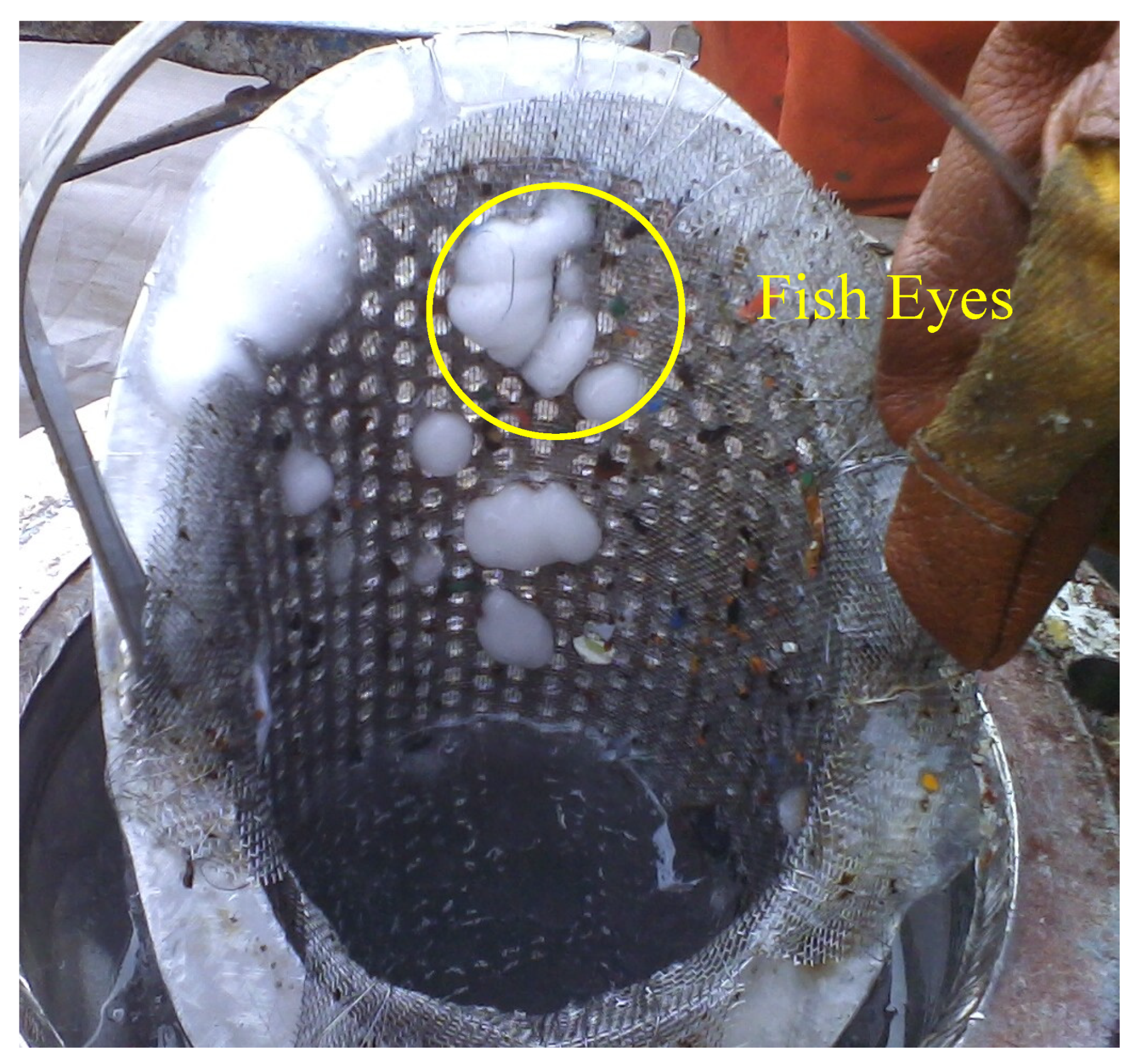

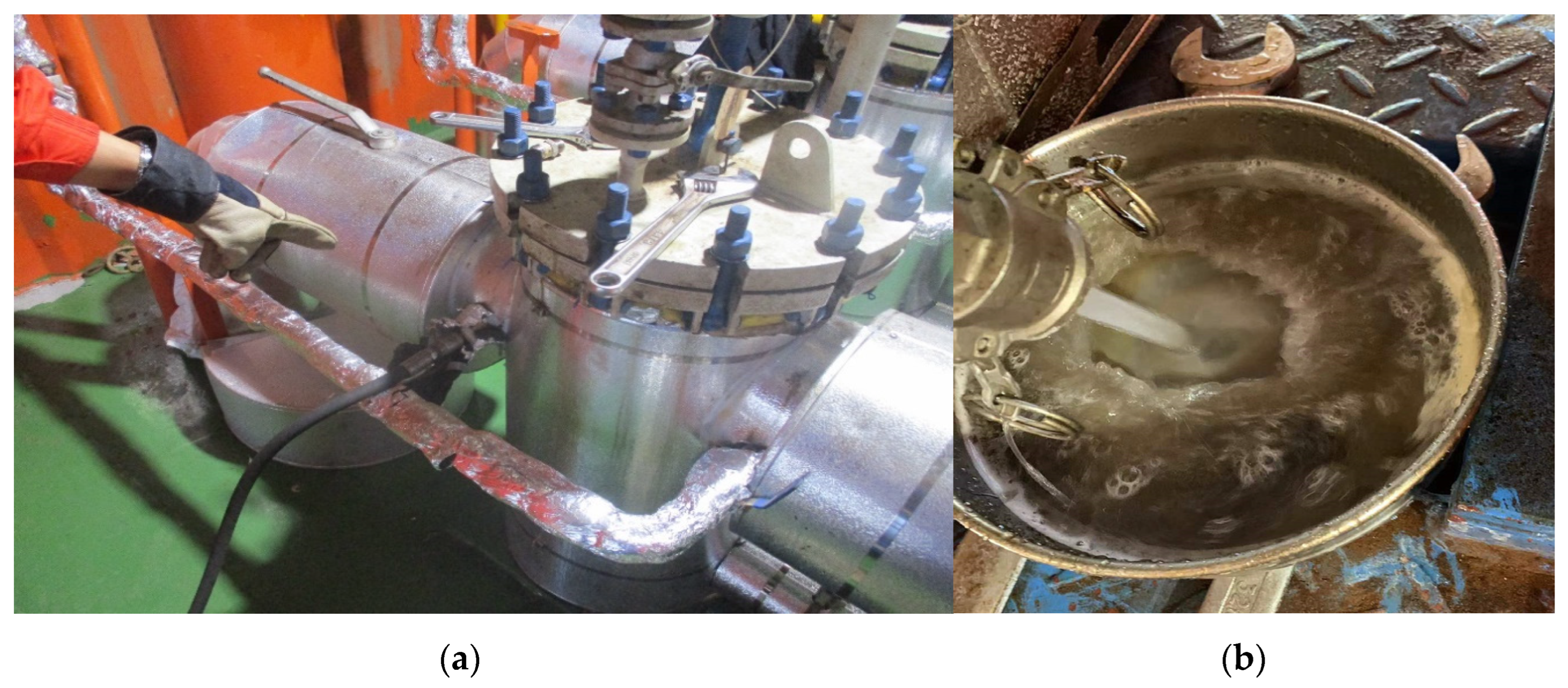
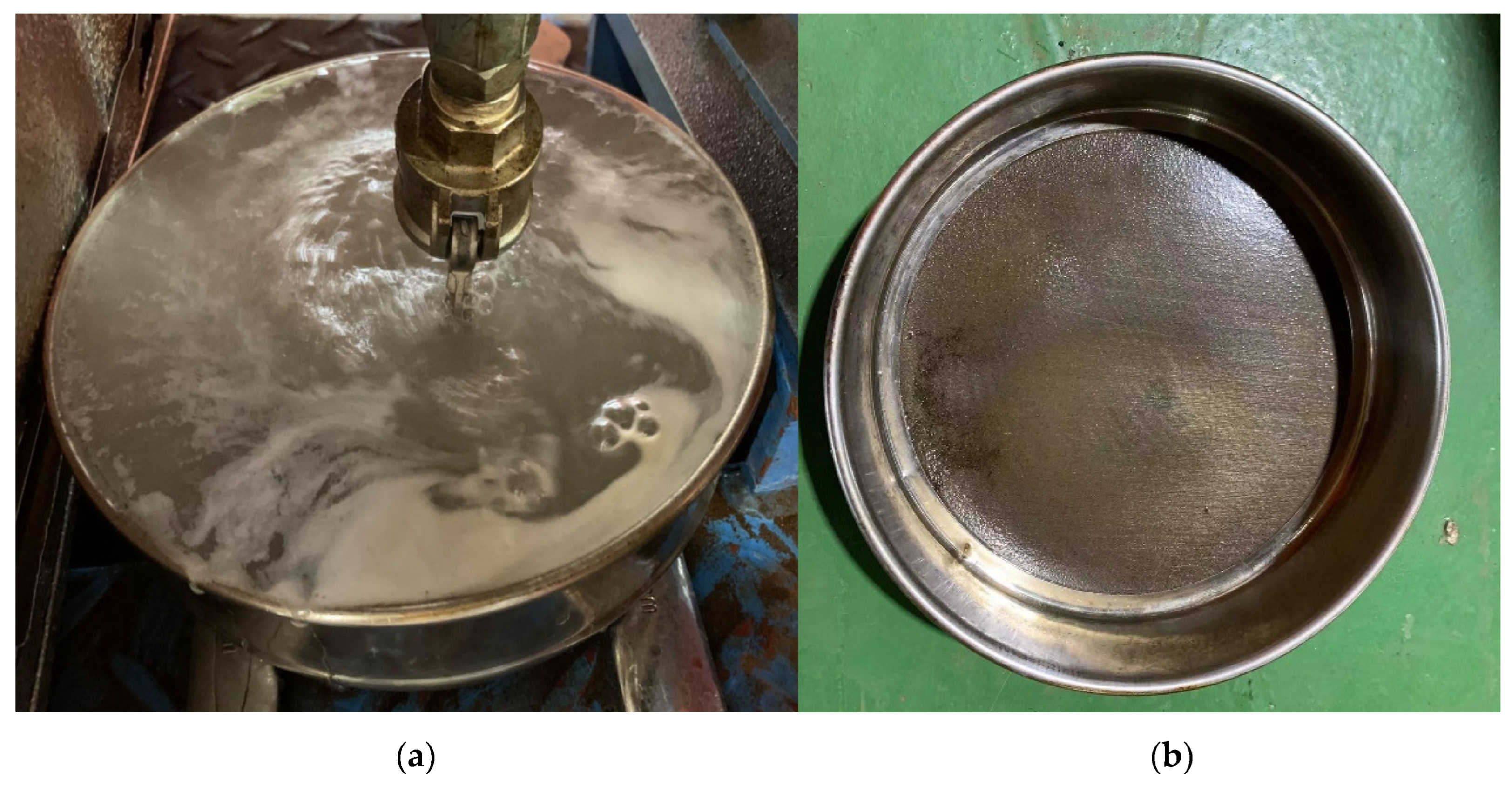

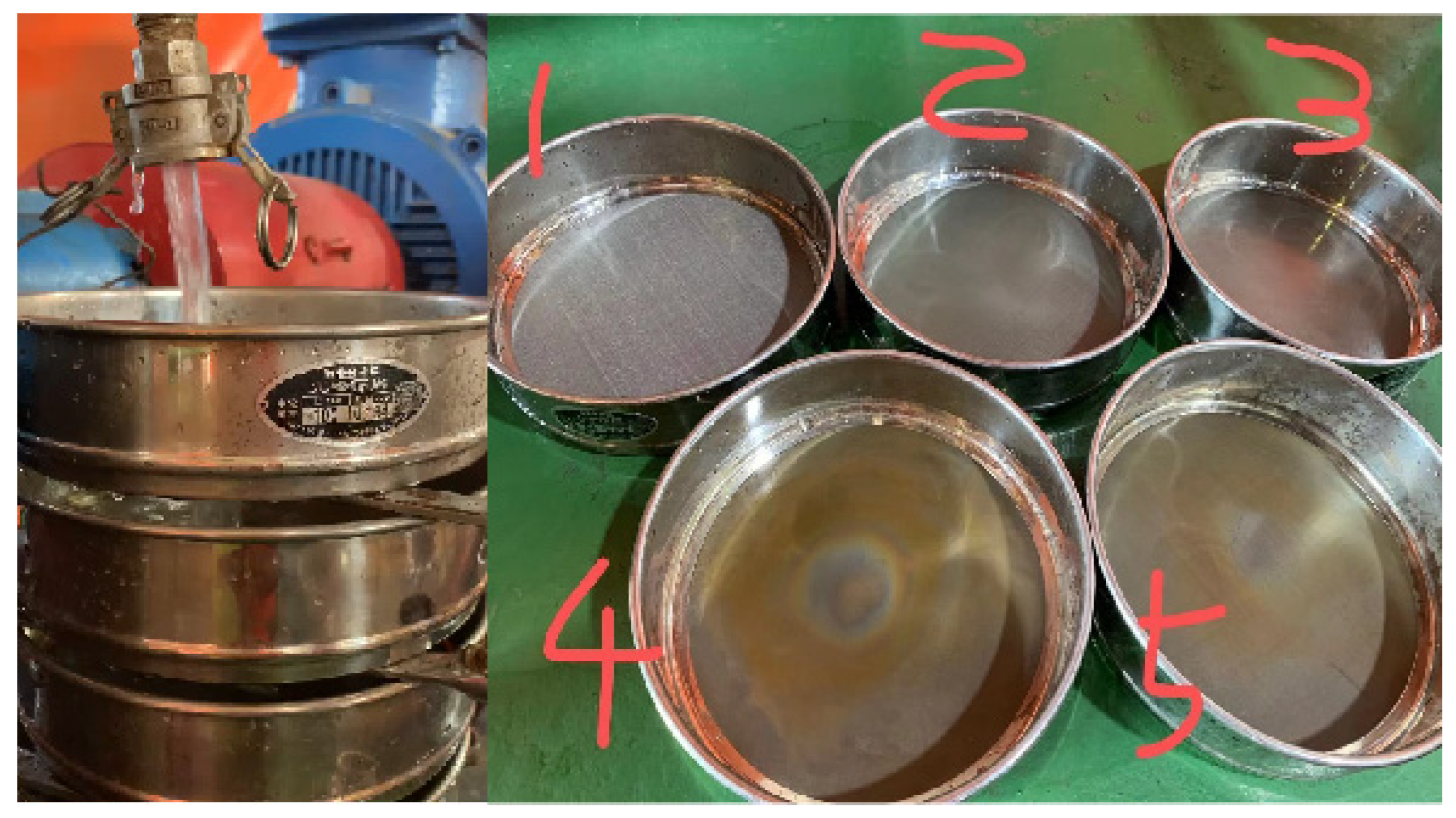






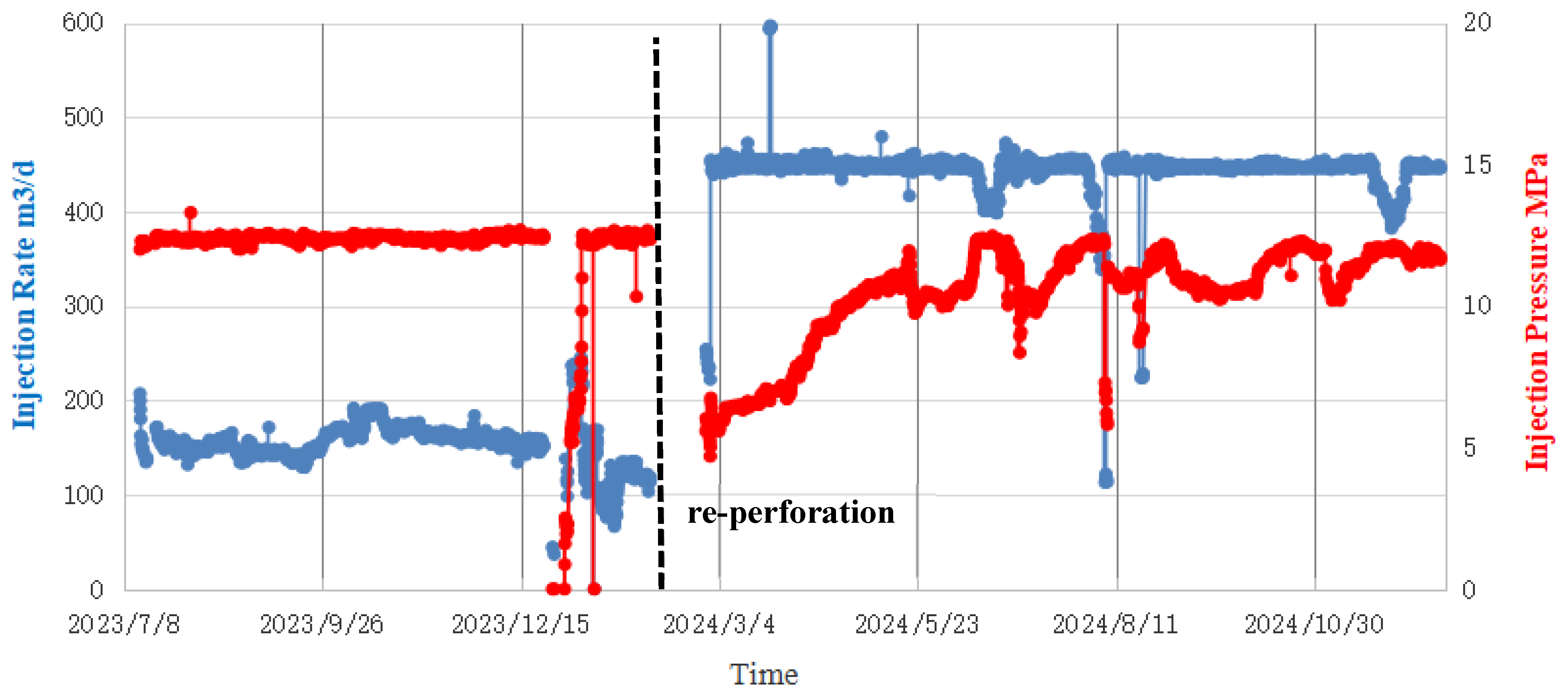
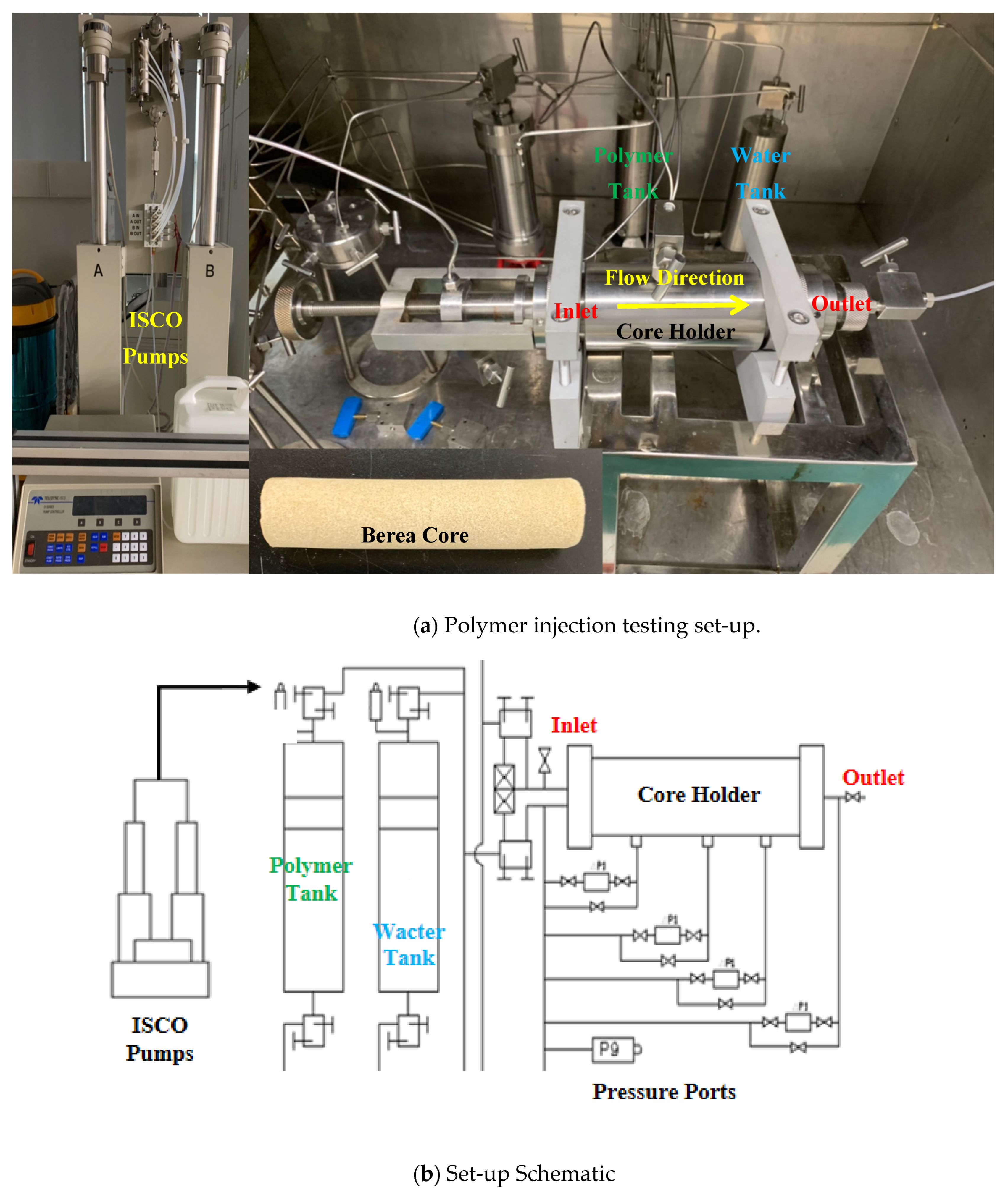
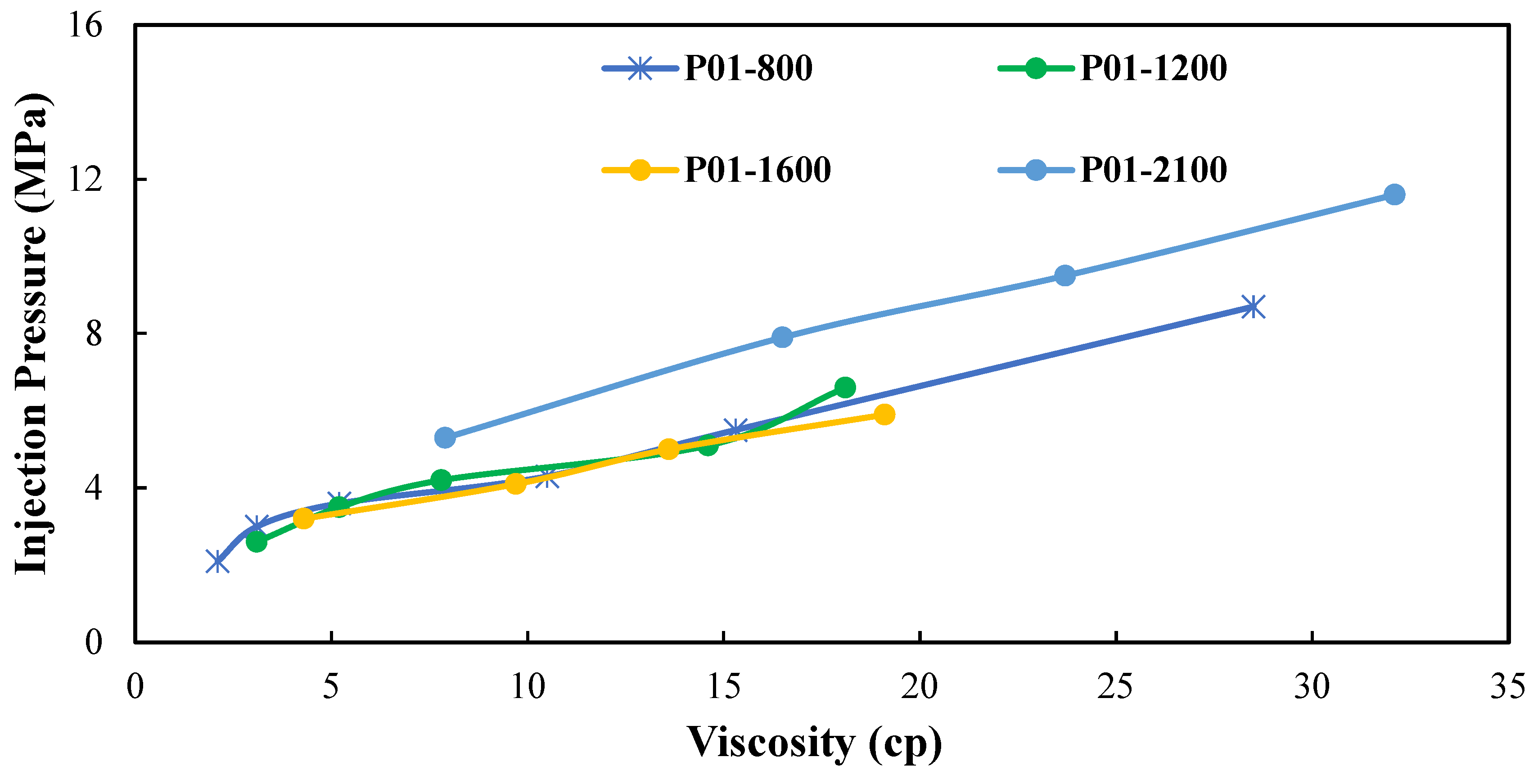
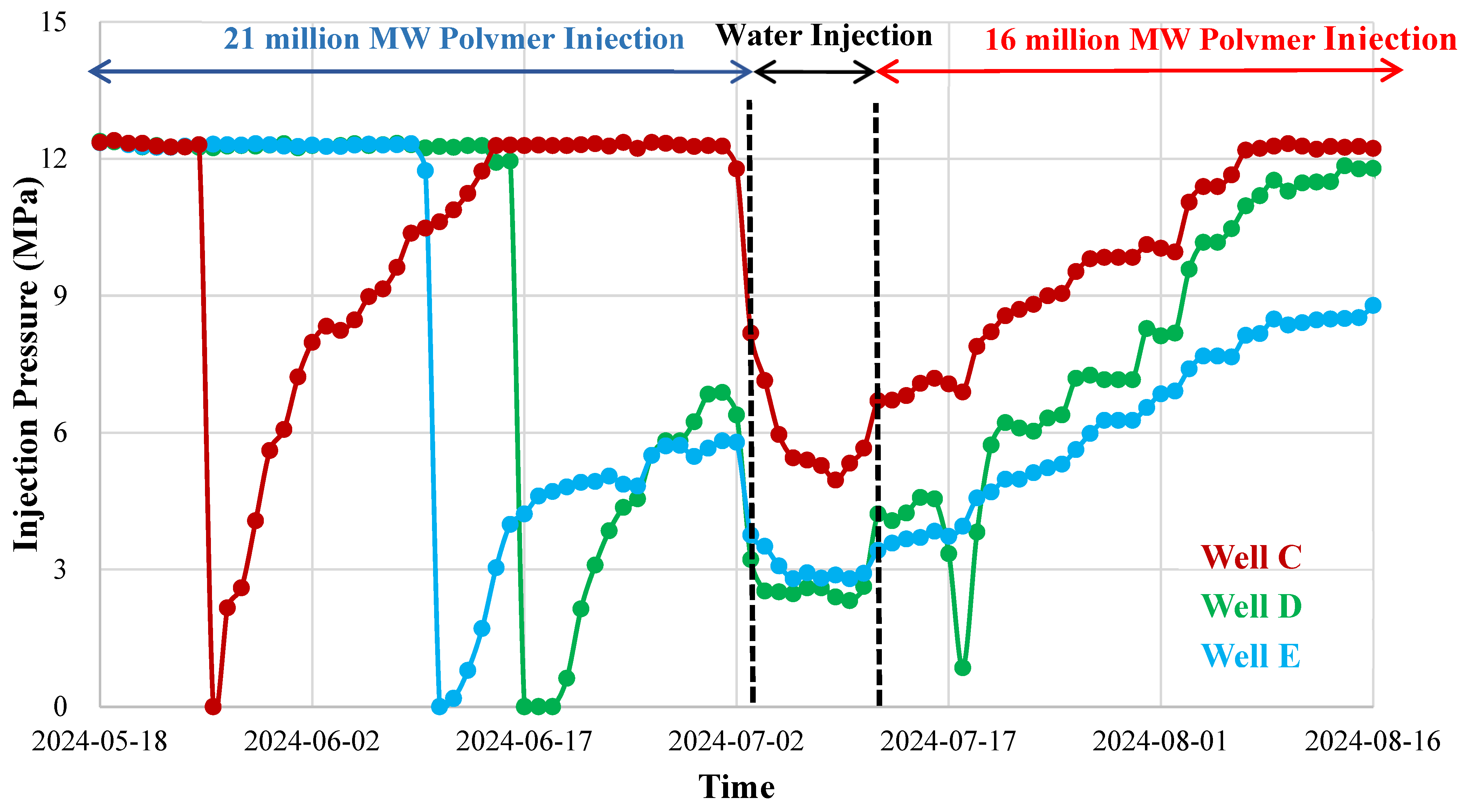
| Mesh Number | Time H |
|---|---|
| 300 | 25 |
| 400 | 12.5 |
| 500 | 2.5 |
| Plugging Percentage | Mesh 100 | Mesh 200 | Mesh 300 | Mesh 400 | Mesh 500 |
| 20% | 40% | 80% | 90% | 100% |
| Before Re-Perforation | After Re-Perforation | |
|---|---|---|
| Height m | 18.3 | 24.2 |
| SPF | 12 | 20 |
| Perforation Diameter m | 0.0153 | 0.008 |
| Perforation Length m | 0.135 | 0.85 |
| Phase | 45/135° | 60/120° |
| Polymer MW | Concentration (ppm) | Viscosity (cp) |
|---|---|---|
| P01-2100 | 500 | 7.9 |
| 800 | 16.5 | |
| 1000 | 23.7 | |
| 1200 | 32.1 | |
| P01-1600 | 500 | 4.3 |
| 800 | 9.7 | |
| 1000 | 13.6 | |
| 1200 | 19.1 | |
| P01-1200 | 500 | 3.1 |
| 800 | 5.2 | |
| 1000 | 7.8 | |
| 1200 | 14.6 | |
| 1600 | 18.1 | |
| >P01-800 | 500 | 2.1 |
| 800 | 3.1 | |
| 1000 | 5.2 | |
| 1200 | 10.5 | |
| 1600 | 15.3 | |
| 2500 | 28.5 |
Disclaimer/Publisher’s Note: The statements, opinions and data contained in all publications are solely those of the individual author(s) and contributor(s) and not of MDPI and/or the editor(s). MDPI and/or the editor(s) disclaim responsibility for any injury to people or property resulting from any ideas, methods, instructions or products referred to in the content. |
© 2025 by the authors. Licensee MDPI, Basel, Switzerland. This article is an open access article distributed under the terms and conditions of the Creative Commons Attribution (CC BY) license (https://creativecommons.org/licenses/by/4.0/).
Share and Cite
Wang, C.; Zhang, J.; Huang, B.; Du, H.; Meng, X.; Li, X.; Xue, X.; Su, Y.; Li, C.; Guo, H. Polymer Flooding Injectivity Maintaining and Enhancement Strategies: A Field Case Study of Chinese Offshore EOR Project. Processes 2025, 13, 903. https://doi.org/10.3390/pr13030903
Wang C, Zhang J, Huang B, Du H, Meng X, Li X, Xue X, Su Y, Li C, Guo H. Polymer Flooding Injectivity Maintaining and Enhancement Strategies: A Field Case Study of Chinese Offshore EOR Project. Processes. 2025; 13(3):903. https://doi.org/10.3390/pr13030903
Chicago/Turabian StyleWang, Chenxi, Jian Zhang, Bo Huang, Hong Du, Xianghai Meng, Xianjie Li, Xinsheng Xue, Yi Su, Chao Li, and Haiping Guo. 2025. "Polymer Flooding Injectivity Maintaining and Enhancement Strategies: A Field Case Study of Chinese Offshore EOR Project" Processes 13, no. 3: 903. https://doi.org/10.3390/pr13030903
APA StyleWang, C., Zhang, J., Huang, B., Du, H., Meng, X., Li, X., Xue, X., Su, Y., Li, C., & Guo, H. (2025). Polymer Flooding Injectivity Maintaining and Enhancement Strategies: A Field Case Study of Chinese Offshore EOR Project. Processes, 13(3), 903. https://doi.org/10.3390/pr13030903





